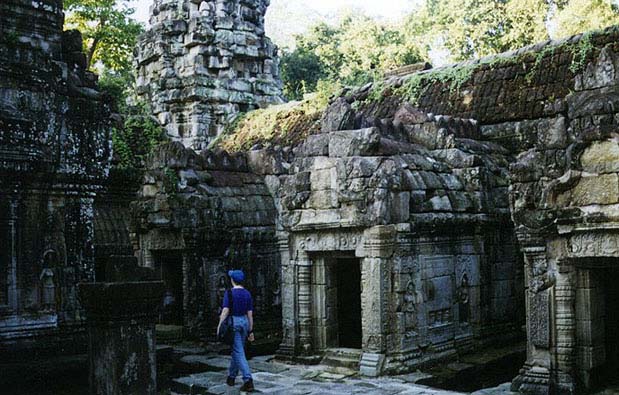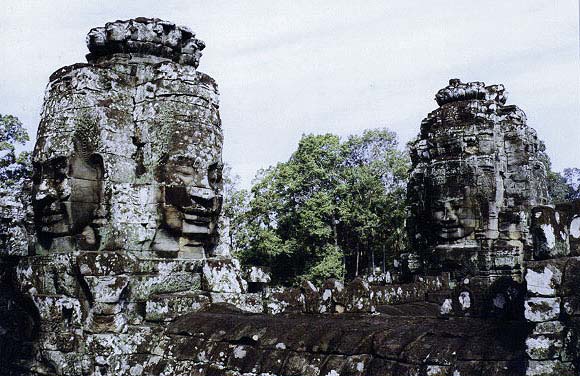
Monday Morning, November 10
Angkor Wat Sunrise, "The Big Circuit"
Once again our pre-dawn alarm managed to get us up for an early morning adventure. Rang wasn't downstairs with the car just yet, so we stood outside admiring the clear night sky, the fresh air and the marvelous view of Orion and the Pleiadies. By 5:15am, Rang's car pulled up in front of the hotel and we were soon on our way to Angkor.
The number of stars dwindled and the sky turned from black to dark blue as we pulled up in front of Angkor Wat's stone causeway. The sun would rise soon after 6am, so that gave us about half an hour to find a good spot. The causeway was deserted apart from some cows grazing to the left of the first gate. Most people go to the Bayon for sunrise, but I figured that there would still be some folks who would come to Angkor Wat, right? But as we entered the main courtyard and approached the wat, we were still the only visitors inside, save a few local Khmers who were starting their work day at a renovation site.
A grassy area behind a large pond appeared to boast the best view of Angkor Wat, so we placed ourselves there and waited. Within a matter of seconds, flies swarmed around our faces, darting back and forth in front of my eyes. To make matters worse, our bug spray was back at the hotel. Susanne took cover under her anorak while I wrapped my trusty krama scarf around my face and head to keep the pesky beasts at bay. A Spanish couple arrived with their Khmer guide and he commented that I was using my krama "like a real Khmer." He asked me where I bought it, and I told him about the Central Market in Phnom Penh. "Oh, no, no," he exclaimed. "Kramas made in Siem Reap, not Phnom Penh. Buy kramas here from now on. Better for Siem Reap." "Not better for Phnom Penh," I replied, smiling. "Next time," he repeated, "buy in Siem Reap. Very good kramas."
Before beginning the Big Circuit, I asked Rang to stop briefly at Angkor Thom's South Gate and the Bayon as well, just for a quick photo shoot. The rising sunlight was spectacular - a thick, bright orange from the morning humidity - I thought it would be a waste to not try to capture it. After a few photos I hopped back into the car and we drove north through Angkor Thom to Preah Khan, which is believed to be a temporary residence for Jayavarman VII
Rang drove us east to the temple of Preah Neak Pean, but our stay was quite short for the only entrance to the site was flooded from the monsoon. Some local kids offered to push us through the water on their bikes, but the thought of having water and mud spraying all over our clothes caused us to decline their generosity. We moved on to our next stop, Ta Som. Today would be dedicated mostly to the circle of ruins collectively known as the Big Circuit, but first we had a more pressing agenda: to watch the sunrise over Angkor Wat.
Today would be dedicated mostly to the circle of ruins collectively known as the Big Circuit, but first we had a more pressing agenda: to watch the sunrise over Angkor Wat.
The flies died down as the sky brightened. Several bats swooped over the pond, savoring mouthfuls of bugs with each pass. I rooted for the bats. More tourists entered the courtyard but there were still no more than 15 of us at the time. While we maintained our spot near the pond, the others gathered on the causeway itself, about 100 yards in front of the wat. They were treated with the first rays of sunlight that morning - the stone towers obscured the sun from reaching our pond spot as quickly. Eventually, we were greeted with the yellow beams reflecting off of the shimmering pool in front of us. Sunrise at Angkor Wat. Well worth the wait, even with all of those flies.

Wide-angle view of the Angkor Wat pond  . Preah Khan is a large stone temple that remains in good condition, despite the piles of rubble that litter the site. As soon as we entered it, a young boy latched on to us and followed us around. He started to point out things that we already knew - "Preah Khan, very big, very old" so I told him we really weren't in need of a guide. Undeterred, he continued to stalk us, always within a 20 foot range.
. Preah Khan is a large stone temple that remains in good condition, despite the piles of rubble that litter the site. As soon as we entered it, a young boy latched on to us and followed us around. He started to point out things that we already knew - "Preah Khan, very big, very old" so I told him we really weren't in need of a guide. Undeterred, he continued to stalk us, always within a 20 foot range.
We climbed through an obstacle course of stone to reach the east side of the temple, where large trees had sprung from the walls of the temple itself. We cut through the center of the complex to a small stupa, about waste high. Bats flew through the corridor, prompting me to wrap my krama around my head. As we exited the temple, the young boy simply walked away without asking for money. That was a first for us at Angkor. He might have just been a bit lonely - we were the only visitors there at that time of day - and we felt bad for ignoring him so much.

Andy by a large tree behind Preah Khan
 |
| Main Courtyard, Ta Som |
Ta Som was a minor temple built by Jayavarman VII. No one ever visits it, and the LP guide barely gives it a sentence's mention. But we decided to check it out nonetheless. The path to Ta Som was covered in sand - I felt like we were at the beach. Passing through a stone gate we found a small temple whose insides were a complete mess. Columns overturned, boulders and other debris littered about like a earthquake victim, but the anarchy of the stones made the temple into a venerable jungle gym for our climbing pleasure.
 |
| Susanne wanders the hallways of Ta Som |
 |
| Andy captures an elephant at the Eastern Mebon |
 |
| Avelokitesvara heads, the Bayon |
 head that was relatively close to eye level, and proceeded to spend the next hour drawing it. The head was just a few feet from that amputee musician who played the Khmer folk cello. We sat there sketching the face, listening to the sound of Cambodian melodies rise through the air. We noticed that the musician had a friend nearby, to whom he would hand any recent donations from tourists - that way, the musician's money bowl always seemed pathetically barren. In the time we sat there, he probably collected five dollars in small bills, not bad money by local standards. Several Khmer teenagers approached us to watch us draw; they smiled when they saw what we were doing. By 11:30 we were both satisfied with our work so we paused for a few more pictures of us standing by the stone face. We then returned to the car and drove back to Siem Reap for our lunchtime break.
head that was relatively close to eye level, and proceeded to spend the next hour drawing it. The head was just a few feet from that amputee musician who played the Khmer folk cello. We sat there sketching the face, listening to the sound of Cambodian melodies rise through the air. We noticed that the musician had a friend nearby, to whom he would hand any recent donations from tourists - that way, the musician's money bowl always seemed pathetically barren. In the time we sat there, he probably collected five dollars in small bills, not bad money by local standards. Several Khmer teenagers approached us to watch us draw; they smiled when they saw what we were doing. By 11:30 we were both satisfied with our work so we paused for a few more pictures of us standing by the stone face. We then returned to the car and drove back to Siem Reap for our lunchtime break.
|
|
|
|
|
previous diary |
diary index |
next diary |